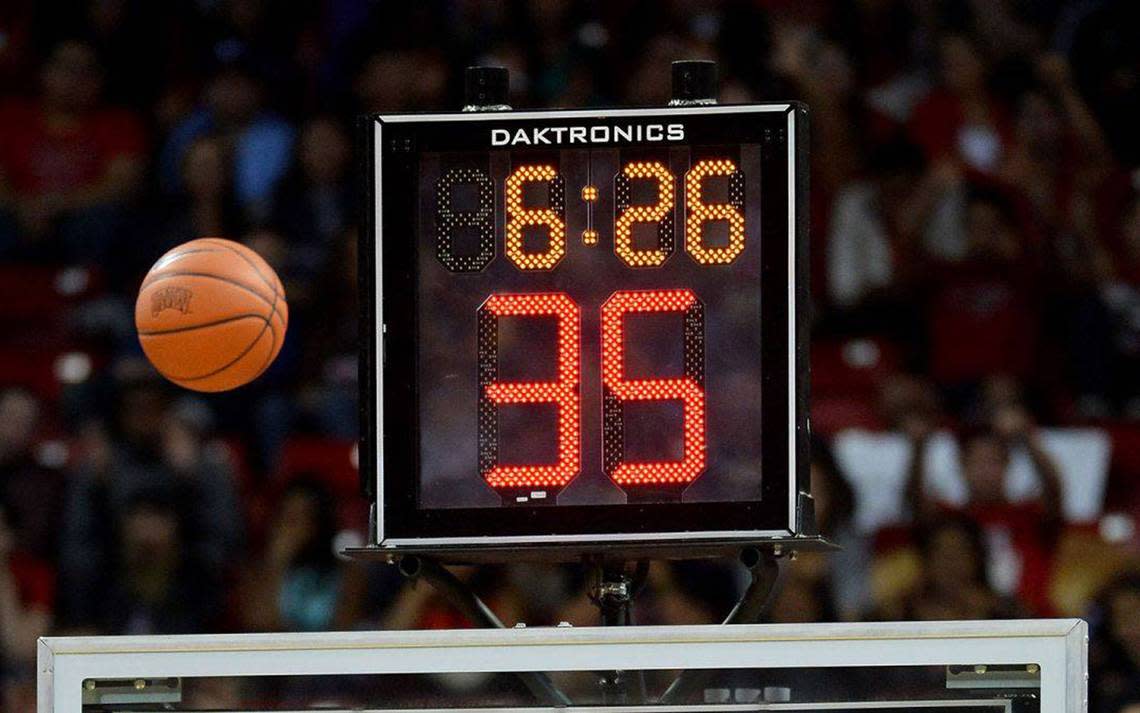Are shot clocks in Texas high school basketball’s future? Most coaches want them.

When the National Federation of State High Schools Associations announced shot clock’s could be implemented in high school basketball starting with the 2022-2023 season, 27 state associations started utilizing them.
Texas’ University Interscholastic League, however, does not.
That could soon change.
Last year’s Texas Association of Basketball Coaches survey has created some momentum for a rule change. The majority (61.65%) voiced their support for the addition of shot clocks, and more than 80% of the Texas high school coaches responded according to TABC President Tyler Helms.
No decision has been made, but the UIL has recognized the growing support from the coaches.
UIL Deputy Director Jamie Harrison said a five-year timeline for adding shot clocks in Texas basketball is a “realistic option” and implementing the change for the start of the 2027 season is the “fastest realistic pace.”
Although most coaches support the idea, there are more opinions at play. The next step, according to Helms, will be getting administrators and superintendents to overwhelmingly support the idea.
If a decision is made, Harrison said time will be needed to acquire and install the shot clocks. Operators will need to be trained, and a trial period must occur before clocks can be implemented as a requirement.
Plenty of obstacles to overcome
In Thursday’s Class 5A state semifinal between Lancaster and Amarillo, the Tigers held the ball at half court for over a minute and 30 seconds with only a five-point lead in the second quarter. The Amarillo defense refused to add pressure and Lancaster wanted the final shot of the half.
Lancaster held the ball for over 1 min and 30 seconds with only a five point lead in the second quarter… and fans start to boo at the Alamodome.
No shot clocks in UIL basketball. Stalling is commonplace but I’ve never seen it like this in Q2. Lancaster leads 13-8 at half. pic.twitter.com/NZKFiaSwxB— Charles Baggarly (@swaggarly) March 8, 2024
Lancaster took a 13-8 lead into the half, eventually breaking the 5A state tournament record for fewest points allowed with a 44-31 victory.
Obviously, the use of shot clock would eliminate this tactic and force all involved to play. Fixing the issue is easier said than done, however, and Harrison said the UIL is dealing with a “pretty significant puzzle with a lot of complexity.”
The biggest problem the UIL faces when it comes to shot clock implementation has to do with the cost. Schools are not receiving enough state and federal funding to allocate resources to rule changes.
How much can a shot clock cost? Patrick Carr of the Ogden Standard Examiner reported shot clocks cost “anywhere between $3,500-$6,000.”
That hefty sum doesn’t include installation and game payments for shot clock operators.
The UIL is already dealing with a widespread officiating shortage. Harrison said the UIL will need to decide whether to hire trained officials to run the shot clock. The other option is letting schools or host sites find operators.
Even if schools had the necessary funding to implement shot clocks into UIL basketball, there are still plenty of decisions to be made. Although the majority of coaches support, there are many that oppose the idea.
Helm’s biggest takeaway from the TABC survey data is larger classifications “overwhelmingly support” shot clocks while smaller schools are more likely to resist. Only 42% of Class 1A boys coaches support the addition compared to 86% of Class 6A coaches.
Lipan head coach Brent Gaylor, fresh off a Class 2A state championship win, said he does not support a shot clock because it’s hard to find operators. He said teams should not be faulted for stalling and considers it to be a strategy.
“If you don’t like it, figure out a way to stop it,” Gaylor said.
The TABC, on the social platform X, said determining which classifications use clocks is a question that needs to be answered.
In addition, a decision needs to made regarding what grade level to begin shot clock usage. Will shot clocks be required starting in seventh grade? Will shot clocks be optional at the junior varsity level?
National Federation of State High School Associations deemed 35 second shot clocks are acceptable, but Harrison suggested there is still dialogue regarding the maximum duration of a possession. Also, will the clock reset on an offensive rebound?
There are also discussions surrounding whether there should be different sets of shot clocks rules for boys and girls basketball.
“It’s real easy to say, ‘should we have a shot clock or should we not?’” Harrison said. “If you want to talk about having a shot clock — going through all the laundry list of items. Sorting through all of that in a state as diverse as ours. We have schools that play basketball with less than 10 kids ... all the way up to 7,000 kids.”
Helms said the most common argument for the use of shot clocks deals with the pace of play and added most coaches don’t want teams to deliberately waste possessions and stall with a lead.
Harrison said the loudest voices come from coaches who want to play a fast paced game and have had a hard time preventing teams from holding the ball.
Coaches also want to prepare their athletes for the next level, and a shot clock would simulate a professional or collegiate environment. Many coaches share the same opinion as LeBron James, who voiced his support for shot clocks in amateur basketball on X.
“Cool cool cool but when will the Board of Directors approved a shot clock for Boys & Girls basketball???,” James wrote on Feb. 16. “We have to grow our kids motors, minds and style of play.”


